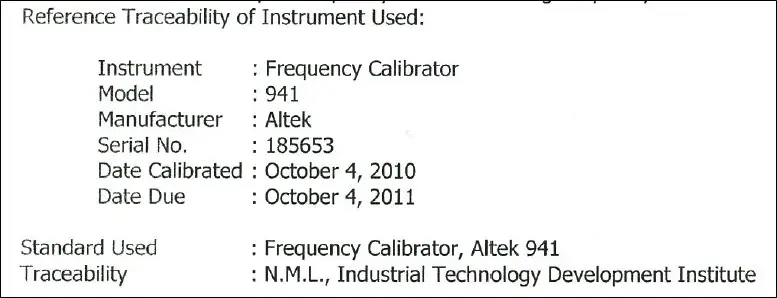Below are the Specific Calibration Certificates Requirements Based on ISO 17025:
A title (calibration certificate).
The name and the Address of the Calibration Laboratory.
Unique identification number of the calibration certificate and the pages until the last page of the calibration certificate ( an example is a serial number; page 2 of 2).
The name and contact details of the customer.
Identification of the calibration method.
A description of the condition and identification of item calibrated.
The date of the receipt of the calibrated item and the date of the calibration.
The date of issue of the calibration certificate.
Calibration results and the unit of measurement. (see below table-under correction or error)
The names, functions, and signature of persons authorizing calibration report.
A statement to the effect that the results relate only to the item calibrated.
Any addtions, deviations or exclusions made during the calibration.
Deviation from the calibration method, and information on specific calibration conditions such as environmental conditions (an example is a limited calibration).
Where relevant, a statement of conformity with requirements and specification.
The result of the estimated measurement uncertainty of the equipment (see below sample tables).
Where appropriate and needed opinion and interpretations.
The environmental conditions under which the calibrations were made that have an influence on the measurement results;
evidence that the measurements are traceable to SI units of measurements.

Example of a Traceability statement
Other evidence of traceability that can be seen in the calibration certificate are:
The LOGO of the accreditation body
Measurement Uncertainty results
The details of the reference standard used
The Measurement results

Example of Accreditation Body Logo with reference number 
Example of Reference Standard description 
Complete details of reference standard used with the name of the National or International lab that performs the calibration A statement specifying that the calibration certificate shall not be reproduced except in full, without the written approval of the laboratory. (This is usually seen at the bottom of the certificate.); … What does this mean?
>> It means that the calibration certificate cannot be reproduced (to make another copy) in part only where some page is missing (in cases where there are multiple pages). Certificates are allowed to be reproduced considering that it was reproduced with a complete number of pages. This will ensure that the user will get the complete information, and therefore, proper interpretation of data results. In any case, if you want to reproduce it with one part only (1 page only), ask first for the approval of the laboratory.
>> To understand easily, let us take the opposite statement, which can be: “The calibration certificate can only be reproduced in complete pages only.”

an example of remarks regarding the reproduction of a calibration certificate Clear identification when the results are from a 3rd party or external providers;
If available, the results before and after adjustments;
Opinions and Interpretations if relevant;
Additional information which may be required by a specific method or customers.
We should consider the above list when creating a format for a calibration certificate, following the requirements above will ensure that all relevant details for a calibration certificate will be covered.
Their location in the calibration certificate is not the same, some certificates are one-paged only while others are 2 pages or more. It depends on the measuring instruments being calibrated.
Furthermore, as per Clause 7.8.1.3, states that “When agreed with the customer, the results may be reported in a simplified way”.
This means that some Information stated above can be omitted or not be reflected in the calibration certificate as long as it is agreed with the customers or users. But make sure that the omitted information is available in the records or raw data. F



















